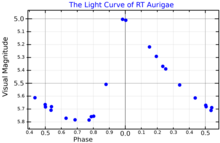RT 아우리개
RT Aurigae| 관측 데이터 에폭 J2000 이쿼녹스 J2000 | |
|---|---|
| 별자리 | 오리가 |
| 우측 상승 | 06h 28m 34.08751s[1] |
| 탈위임 | +30° 29′ 34.92142″[1] |
| 겉보기 크기 (V) | 5.75[2] (5.00 - 5.82[3]) |
| 특성. | |
| 스펙트럼형 | F8Ib[4](F4Ib - G4Ib[3]) |
| U-B색지수 | 0.5[5] |
| B-V색지수 | 0.74[2] |
| 변수형 | Δ Cep[3] |
| 아스트로메트리 | |
| 방사 속도 (Rv) | 20.30km[6]/s |
| 고유 운동 (μ) | RA: 0.34 mas/yr Dec.: -14.95 mas/yr |
| 시차 (π) | -1.10 ± 1.41[1] 마스 |
| 거리 | 473[7] pc |
| 절대치수 (MV) | -3.09[7] |
| 세부 사항 | |
| 미사 | 4.5[8] M☉ |
| 반지름 | 35.1[7] R☉ |
| 루미도 | 1,186[9] L☉ |
| 표면 중력 (log g) | 1.5[2] cgs |
| 온도 | 6,151[9] K |
| 금속성 | 0.1[7] |
| 기타 지정 | |
| 데이터베이스 참조 | |
| 심바드 | 자료 |
| 데이터 원본: | |
| 히파르코스 카다로그, CCDM(2002) Bright Star 카탈로그(5차 개정판) | |
RT 아우리개(RT Aur, 48 Aurlige)는 지구에서 약 1,500광년 떨어진 오리가 별자리에 있는 노란색 초거성 변수 별이다.
RT 아우리개는 F형에서 G형 고전 세페이드 변수로, 3.728309일의 기간으로 규모 +5.00부터 +5.82까지 다양하다.[7]변동성은 1905년에 발견되었다.[11]세페이드 변수의 부류로 빠르게 인식되었지만, 그 성질은 당시에는 파악되지 않았다.밝기 변동에 해당하는 방사상 속도 변화가 감지되었지만, 이러한 변화는 별의 맥박과 온도 변화에 의해 발생한다는 생각은 대부분 이항성의 궤도 운동을 선호하여 기각되었다.[12]보다 정확한 관측 결과, 결국 밝기 변화는 별들의 대기의 맥박에 의해 발생했으며, 별들은 최대 밝기에 가까운 가장 작고 뜨거웠다는 것이 의심할 여지 없이 증명되었다.[13]
그동안 RT오리가 분광형 2진법으로 의심받았지만, 이는 확인되지 않았다.[14][8]가장 강력한 증거는 2013년 CARA 어레이 광학 간섭계를 사용하여 발견되었다.동반자는 초거성 1차성, F0 주계열성보다 6.7배 더 희미하고, 더 차갑고, 더 기절할 것이다.이 두 별은 2.1 밀리 아르크 초로 분리된다.[15]
참조
- ^ a b c Van Leeuwen, F. (2007). "Validation of the new Hipparcos reduction". Astronomy and Astrophysics. 474 (2): 653–664. arXiv:0708.1752. Bibcode:2007A&A...474..653V. doi:10.1051/0004-6361:20078357. S2CID 18759600.
- ^ a b c Soubiran, C.; Le Campion, J. -F.; Cayrel De Strobel, G.; Caillo, A. (2010). "The PASTEL catalogue of stellar parameters". Astronomy and Astrophysics. 515: A111. arXiv:1004.1069. Bibcode:2010A&A...515A.111S. doi:10.1051/0004-6361/201014247. S2CID 118362423.
- ^ a b c Samus, N. N.; Durlevich, O. V.; et al. (2009). "VizieR Online Data Catalog: General Catalogue of Variable Stars (Samus+ 2007-2013)". VizieR On-line Data Catalog: B/GCVS. Originally Published in: 2009yCat....102025S. 1. Bibcode:2009yCat....102025S.
- ^ Eggleton, P. P.; Tokovinin, A. A. (2008). "A catalogue of multiplicity among bright stellar systems". Monthly Notices of the Royal Astronomical Society. 389 (2): 869. arXiv:0806.2878. Bibcode:2008MNRAS.389..869E. doi:10.1111/j.1365-2966.2008.13596.x. S2CID 14878976.
- ^ Ducati, J. R. (2002). "VizieR Online Data Catalog: Catalogue of Stellar Photometry in Johnson's 11-color system". CDS/ADC Collection of Electronic Catalogues. 2237: 0. Bibcode:2002yCat.2237....0D.
- ^ Gontcharov, G. A. (2006). "Pulkovo Compilation of Radial Velocities for 35 495 Hipparcos stars in a common system". Astronomy Letters. 32 (11): 759–771. arXiv:1606.08053. Bibcode:2006AstL...32..759G. doi:10.1134/S1063773706110065. S2CID 119231169.
- ^ a b c d e Groenewegen, M. A. T. (2013). "Baade-Wesselink distances to Galactic and Magellanic Cloud Cepheids and the effect of metallicity". Astronomy & Astrophysics. 550: A70. arXiv:1212.5478. Bibcode:2013A&A...550A..70G. doi:10.1051/0004-6361/201220446. S2CID 118665355.
- ^ a b Turner, D. G.; Bryukhanov, I. S.; Balyuk, I. I.; Gain, A. M.; Grabovsky, R. A.; Grigorenko, V. D.; Klochko, I. V.; Kosa‐Kiss, A.; Kosinsky, A. S.; Kushmar, I. J.; Mamedov, V. T.; Narkevich, N. A.; Pogosyants, A. J.; Semenyuta, A. S.; Sergey, I. M.; Schukin, V. V.; Strigelsky, J. B.; Tamello, V. G.; Lane, D. J.; Majaess, D. J. (2007). "The Period Changes of the Cepheid RT Aurigae". Publications of the Astronomical Society of the Pacific. 119 (861): 1247. arXiv:0709.3085. Bibcode:2007PASP..119.1247T. doi:10.1086/523656. S2CID 18243829.
- ^ a b Turner, D. G. (2010). "The PL calibration for Milky Way Cepheids and its implications for the distance scale". Astrophysics and Space Science. 326 (2): 219–231. arXiv:0912.4864. Bibcode:2010Ap&SS.326..219T. doi:10.1007/s10509-009-0258-5. S2CID 119264970.
- ^ Kiss, Laszlo L. (July 1998). "A photometric and spectroscopic study of the brightest northern Cepheids - I. Observations". Monthly Notices of the Royal Astronomical Society. 297 (3): 825. Bibcode:1998MNRAS.297..825K. doi:10.1046/j.1365-8711.1998.01559.x. Retrieved 19 October 2021.
- ^ Turner, H. H. (1905). "New Variable 47.1905 Aurigae". Astronomische Nachrichten. 168 (2): 29–30. Bibcode:1905AN....168...29T. doi:10.1002/asna.19051680209.
- ^ Duncan, J. C. (1909). "The Orbits of the Cepheid Variables Y Sagittarii and RT Auriga; with a Discussion of the Possible Causes of this Type of Stellar Variation". Publications of the Astronomical Society of the Pacific. 21 (126): 119. Bibcode:1909PASP...21..119D. doi:10.1086/121905.
- ^ Shapley, H. (1916). "The variations in spectral type of twenty Cepheid variables". Astrophysical Journal. 44: 273. Bibcode:1916ApJ....44..273S. doi:10.1086/142295.
- ^ Evans, Nancy R. (1992). "A magnitude-limited survey of Cepheid companions in the ultraviolet". Astrophysical Journal. 384: 220. Bibcode:1992ApJ...384..220E. doi:10.1086/170865.
- ^ Gallenne, A.; Mérand, A.; Kervella, P.; Monnier, J. D.; Schaefer, G. H.; Baron, F.; Breitfelder, J.; Le Bouquin, J. B.; Roettenbacher, R. M.; Gieren, W.; Pietrzyński, G.; McAlister, H.; Ten Brummelaar, T.; Sturmann, J.; Sturmann, L.; Turner, N.; Ridgway, S.; Kraus, S. (2015). "Robust high-contrast companion detection from interferometric observations. The CANDID algorithm and an application to six binary Cepheids". Astronomy & Astrophysics. 579: A68. arXiv:1505.02715. Bibcode:2015A&A...579A..68G. doi:10.1051/0004-6361/201525917. S2CID 1118066.




